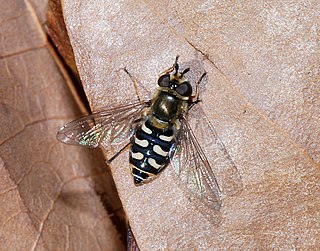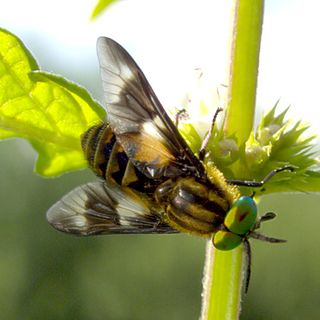 W
WThe Asiloidea comprise a very large superfamily insects in the order Diptera, the true flies. It has a cosmopolitan distribution, occurring worldwide, with many species living in dry, sandy habitat types. It includes the family Bombyliidae, the bee flies, which are parasitoids, and the Asilidae, the robber flies, which are predators of other insects. Members of the other families are mainly flower visitors as adults and predators as larvae.
 W
WThe Bibionoidea are a superfamily within the order Diptera. The following families are included within the Bibionoidea:Bibionidae – March flies Hesperinidae
 W
WCarnoidea are a superfamily of Acalyptratae flies.
 W
WThe Chironomoidea are a superfamily within the order Diptera, suborder Nematocera, infraorder Culicomorpha. This superfamily contains the families Chironomidae, Ceratopogonidae, Simuliidae, and Thaumaleidae. One of the more important characteristics used to define them is the distinctive form of their larval mouthparts.
 W
WThe Conopidae, usually known as the thick-headed flies, are a family of flies within the Brachycera suborder of Diptera, and the sole member of the superfamily Conopoidea. Flies of the family Conopidae are distributed worldwide in all the biogeographic realms except for the poles and many of the Pacific islands. About 800 species in 47 genera are described worldwide, about 70 of which are found in North America. The majority of conopids are black and yellow, or black and white, and often strikingly resemble wasps, bees, or flies of the family Syrphidae, themselves notable bee mimics. A conopid is most frequently found at flowers, feeding on nectar with its proboscis, which is often long.
 W
WThe Culicoidea are a superfamily within the order Diptera. The following families are included within the Culicoidea:Dixidae – meniscus midges Corethrellidae – frog-biting midges Chaoboridae – phantom midges Culicidae – mosquitoes
 W
WThe Diopsoidea are a small but diverse cosmopolitan superfamily of acalyptrate muscoids, especially prevalent in the tropics. Some flux exists in the family constituency of this group, and the final classification is likely to require the use of molecular systematics.
 W
WThe Empidoidea are a large monophyletic superfamily of true flies, the sister taxon to the Muscomorpha (Cyclorrhapha). These two groups are sometimes united in the unranked taxon Eremoneura. There are some 10,000 known species within Empidoidea, which are represented on all continents except Antarctica. They are known to have existed since the Jurassic period.
 W
WThe Ephydroidea are a superfamily of muscomorph flies. Within this superfamily are 9 families of Acalyptratae.
 W
WHippoboscoidea is a superfamily of the Calyptratae. The flies in this superfamily are blood-feeding obligate parasites of their hosts. Four families are often placed here:Glossinidae - Tsetse flies Hippoboscidae - Ked flies Nycteribiidae - Bat flies Streblidae - Bat flies
 W
WThe Lauxanioidea are a superfamily of flies that includes the two large families, the Lauxaniidae and Chamaemyiidae, and the small family Celyphidae. Generally, they are small to medium, densely populated, coloured flies. The Chamaemyiidae and Cremifaniidae live as parasites on insects. The family Celyphidae look like beetles.
 W
WThe Lonchaeoidea are a superfamily of generally small or very small black flies with large heads. It contains two families, the Lonchaeidae and the Cryptochetidae. The superfamily was established by G. C. Griffiths in 1972 and came into general use as such.
 W
WMuscoidea is a superfamily of flies in the subsection Calyptratae. Muscoidea, with approximately 7000 described species, is nearly 5% of the known species level diversity of the Diptera, the true flies. Most muscoid flies are saprophagous, coprophagous or necrophagous as larvae, but some species are parasitic, predatory, or phytophagous. In September 2008, a study was done on the superfamily using both nucleic and mitochondrial DNA and the conclusion suggested that Muscoidea may actually be paraphyletic.
 W
WNemestrinoidea is a small, monophyletic superfamily of flies, whose relationship to the other Brachycera is uncertain; they are sometimes grouped with the Tabanomorpha rather than the Asilomorpha. They are presently considered to be the sister taxon to the Asiloidea. The group contains two very small extant families, the Acroceridae and Nemestrinidae, both of which occur worldwide but contain only small numbers of rare species. One extinct family, Rhagionemestriidae, is also included in Nemestrinoidea.
 W
WNerioidea is a superfamily of Acalyptratae flies.
 W
WOestroidea is a superfamily of Calyptratae including the blow flies, bot flies, flesh flies, and their relatives.
 W
WThe Opomyzoidea are a superfamily of flies.
 W
WThe Platypezoidea are a superfamily of true flies of the section Aschiza. Their closest living relatives are the Syrphoidea, which, for example, contain the hoverflies. Like these, the adults do not burst open their pupal cases with a ptilinum when hatching, thus the Aschiza do not have the inverted-U-shaped suture above the antennae. They are, however, muscomorphs, thus have a particular type of pupal case resembling a rounded barrel and called puparium.
 W
WPsychodidae, called drain flies, sink flies, filter flies, sewer flies, or sewer gnats, is a family of true flies. Some genera have short, hairy bodies and wings giving them a "furry" moth-like appearance, hence one of their common names, moth flies. Members of the sub-family Phlebotominae which are hematophagous may be called sand flies in some countries, although this term is also used for other unrelated flies.
 W
WSciaroidea is a superfamily in the infraorder Bibionomorpha. There are about 16 families and more than 15,000 described species in Sciaroidea. Most of its constituent families are various gnats.
 W
WSciomyzoidea is a superfamily of Acalyptratae flies.
 W
WSphaeroceroidea is a superfamily of flies. It includes the cosmopolitan families of Sphaeroceridae, Heleomyzidae, and Chyromyidae, as well as a few smaller groups.
 W
WStratiomyoidea is a superfamily of flies.
 W
WThe Syrphoidea are a superfamily of flies containing only two families under present classification, one of which (Syrphidae) has a great number of the most common and familiar flies. One of these familiar flies is Eristalis tenax, or otherwise known as the drone fly.
 W
WSuperfamily Tabanoidea are insects in the order Diptera.
 W
WThe Tephritoidea are a superfamily of flies. The following families are included:Ctenostylidae Pallopteridae — flutter flies Piophilidae — skippers Platystomatidae — signal flies Pyrgotidae Richardiidae Tephritidae — fruit flies Ulidiidae (Otitidae) — picture-winged flies
 W
WTipuloidea is a superfamily of flies containing the living families Cylindrotomidae, Limoniidae, Pediciidae and Tipulidae, and the extinct families Architipulidae and Eolimnobiidae.
 W
WThe superfamily Trichoceroidea includes one family: Trichoceridae, or winter crane flies,
 W
WThe Brachyceran infraorder Xylophagomorpha is a small group that consists solely of the family Xylophagidae, which presently contains subfamilies that were sometimes considered to be two small related families. Other obsolete names for members of this family include Exeretonevridae and Heterostomidae.